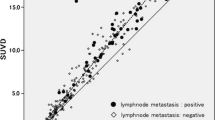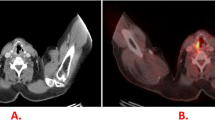Abstract
Objective
2-[18F]Fluoro-2-deoxyglucose positron emission tomography (FDG-PET) is routinely used for the diagnosis of primary lung cancer. However, the role of FDG-PET in the diagnosis and staging of small-sized lung cancer has not been sufficiently evaluated. The purpose of this study was to determine the utility of FDG-PET for preoperative staging of solid-type small-sized lung cancer manifesting as solid-component predominant nodules.
Methods
One-hundred and eighteen patients with solid-type small-sized (≤2 cm) lung cancer diagnosed as clinical stage IA based on thin-slice computed tomography (TS-CT) were included in this study. Before surgery, FDG-PET was performed in 78 patients (CT/PET group), and TS-CT alone was performed in 40 patients (CT group). Clinical and pathological stage and prognosis were retrospectively reviewed according to whether FDG-PET had been performed.
Results
No significant differences in clinical factors were observed when comparing the CT/PET group and the CT group. Of the 78 patients in the CT/PET group, 12 (15.4 %) were diagnosed with clinical stage IIA or IIIA disease based on FDG-PET findings, but no advanced cases with contraindications for curative surgery were seen. In the CT/PET group, the pathological stage was IA in 66 patients, IB in eight patients, IIA in one patient, and IIIA in three patients; 16 patients had incorrectly staged disease. The accurate staging rate was 79.5 % for the CT–PET group and 70.0 % for the CT group (P = 0.262). Among patients diagnosed with clinical stage IA disease, the 3-year overall survival rate was 85.5 % for the 66 patients in the CT/PET group and 76.8 % for the 40 patients in the CT group (P = 0.554). No significant difference was observed in accuracy of preoperative staging and prognosis between the two groups.
Conclusions
FDG-PET produced no clear benefit for the preoperative management of patients with solid-type clinical T1aN0M0 lung cancer, in terms of postoperative survival and the concordance rate of clinical and pathological stage.



Similar content being viewed by others
References
Gould MK, Kuschner WG, Rydzak CE, Maclean CC, Demas AN, Shigemitsu H, et al. Test performance of positron emission tomography and computed tomography for mediastinal staging in patients with non-small-cell lung cancer: a meta-analysis. Ann Intern Med. 2003;139:879–92.
Lardinois D, Weder W, Hany TF, Kamel EM, Korom S, Seifert B, et al. Staging of non-small-cell lung cancer with integrated positron-emission tomography and computed tomography. N Engl J Med. 2003;348:2500–7.
Kubota K, Murakami K, Inoue T, Saga T, Shiomi S. Additional effects of FDG-PET to thin-section CT for the differential diagnosis of lung nodules: a Japanese multicenter clinical study. Ann Nucl Med. 2011;25:787–95.
Kubota K, Murakami K, Inoue T, Itoh H, Saga T, Shiomi S, et al. Additional value of FDG-PET to contrast enhanced-computed tomography (CT) for the diagnosis of mediastinal lymph node metastasis in non-small cell lung cancer: a Japanese multicenter clinical study. Ann Nucl Med. 2011;25:777–86.
Kim BT, Lee KS, Shim SS, Choi JY, Kwon OJ, Kim H, et al. Stage T1 non-small cell lung cancer: preoperative mediastinal nodal staging with integrated FDG PET/CT—a prospective study. Radiology. 2006;241:501–9.
Yi CA, Lee KS, Kim BT, Shim SS, Chung MJ, Sung YM, et al. Efficacy of helical dynamic CT versus integrated PET/CT for detection of mediastinal nodal metastasis in non-small cell lung cancer. Am J Roentgenol. 2007;188:318–25.
Sawabata N, Miyaoka E, Asamura H, Nakanishi Y, Eguchi K, Mori M, et al. Japanese lung cancer registry study of 11,663 surgical cases in 2004. Demographic and prognosis changes over decade. J Thorac Oncol. 2011;6:1229–35.
Detterbeck FC, Falen S, Rivera MP, Halle JS, Socinski MA. Seeking a Home for a PET Part 2: defining the appropriate place for positron emission tomography imaging in the staging of patients with suspected lung cancer. Chest. 2004;125:2300–8.
Li X, Zhang H, Xing L, Ma H, Xie P, Zhang L, et al. Mediastinal lymph nodes staging by 18F-FDG PET/CT for early stage non-small cell lung cancer: a multicenter study. Radiother Oncol. 2012;102:246–50.
Lee SM, Park CM, Paeng JC, Im HJ, Goo JM, Lee HJ, et al. Accuracy and predictive features of FDG-PET/CT and CT for diagnosis of lymph node metastasis of T1 non-small-cell lung cancer manifesting as a subsolid nodule. Eur Radiol. 2012;22:1556–63.
Sobin L, Gospodarowicz M, Witterkind C. International Union against Cancer: TNM Classification of Malignant Tumors. 7th ed. New York: Wiley; 2009.
Travis WD, Colby TB, Corrin B, Shimosato Y, Brambilla E. Histological typing of tumors of lung and pleura. In: Sobin LH, editor. World Health Organization international classification of tumours. 3rd ed. New York: Springer; 1999. p. 21–47.
Sanli M, Isik AF, Zincirkeser S, Elbek O, Mete A, Tuncozgur B, et al. Reliability of positron emission tomography–computed tomography in identification of mediastinal lymph node status in patients with non-small cell lung cancer. J Thoracic Cardiocasc Surg. 2009;138:1200–5.
Cheran SK, Herndon JE 2nd, Patz EF Jr. Comparison of whole’ body FDG-PET to bone scan for detection of bone metastases in patients with a new diagnosis of lung cancer. Lung Cancer. 2004;44:317–25.
van Tinteren H, Hoekstra OS, Smit EF, van den Bergh JH, Schreurs AJ, Stallaert RA, et al. Effectiveness of positron emission tomography in the preoperative assessment of patients with suspected non-small-cell lung cancer: the PLUS multicentre randomised trial. Lancet. 2002;359:1388–93.
Fischer B, Lassen U, Mortensen J, Larsen S, Loft A, Bertelsen A, et al. Preoperative staging of lung cancer with combined PET-CT. N Engl J Med. 2009;361:32–9.
Maziak DE, Darling GE, Inculet RI, Gulenchyn KY, Driedger AA, Ung YC, et al. Positron emission tomography in staging early lung cancer: a randomized trial. Ann Intern Med. 2009;151:221–8.
Viney RC, Boyer MJ, King MT, Kenny PM, Pollicino CA, McLean JM, et al. Randomized controlled trial of the role of positron emission tomography in the management of stage I and II non-small-cell lung cancer. J Clin Oncol. 2004;22:2357–62.
Silvestri GA, Gould MK, Margolis ML, Tanoue LT, McCrory D, Toloza E, et al. Noninvasive staging of non-small cell lung cancer: ACCP evidence-based clinical practice guidelines, 2nd edn. Chest. 2007;132:178S–201S.
Gregory DL, Hicks RJ, Hogg A, Binns DS, Shum PL, Milner A, et al. Effect of PET/CT on management of patients with non-small cell lung cancer: results of a prospective study with 5-year survival data. J Nucl Med. 2012;53:1007–15.
Dinan MA, Curtis LH, Carpenter WR, Biddle AK, Abernethy AP, Patz EF Jr, et al. Stage migration, selection bias, and survival associated with the adoption of positron emission tomography among medicare beneficiaries with non–small-cell lung cancer, 1998–2003. J Clin Oncol. 2012;30:2725–30.
Gill RS, Perry T, Abele JT, Bédard EL, Schiller D. The clinical significance of incidental intra-abdominal findings on positron emission tomography performed to investigate pulmonary nodules. World J Surg Oncol. 2012. doi:10.1186/1477-7819-10-25.
Lin M, Ambati C. The management impact of clinically significant incidental lesions detected on staging FDG PET-CT in patients with non-small cell lung cancer (NSCLC): An analysis of 649 cases. Lung Cancer. 2012;76:344–9.
Conflict of interest
All authors declare that they have no competing interests.
Author information
Authors and Affiliations
Corresponding author
Rights and permissions
About this article
Cite this article
Saisho, S., Yasuda, K., Maeda, A. et al. Role of 2-[18F]fluoro-2-deoxyglucose positron emission tomography in preoperative management of solid-type small-sized lung cancer. Ann Nucl Med 27, 515–522 (2013). https://doi.org/10.1007/s12149-013-0715-7
Received:
Accepted:
Published:
Issue Date:
DOI: https://doi.org/10.1007/s12149-013-0715-7




